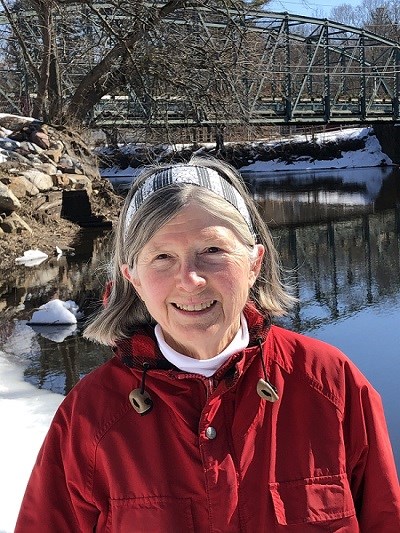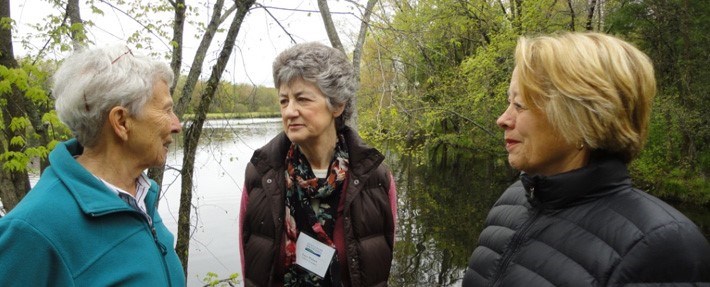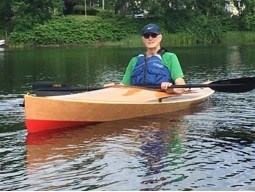Last updated: April 12, 2021
Article
Partner Spotlight | Interview with the Chairs of the Newest PWSRs
by Cassidy Quistorff, NPS Communications Fellow
The newest Partnership Wild and Scenic Rivers were designated in March of 2019. They share in the opportunity as PWSRs to be federally recognized and supported while being locally managed and maintained. We had the great pleasure to sit down (virtually) with Sally Rieger, Lucy Wallace, and Jon Ericson (listed alphabetically by river) to hear about their early experiences with designation. They discussed the formations of their post-designation committees, current projects, and challenges they’ve faced in these first years. The Chairs saw overlap in challenges and opportunities that have presented themselves over these two years, and hope to continue their dialog moving forward.

Sally Rieger – Lower Farmington and Salmon Brook Wild & Scenic Rivers, CT
Lower Farmington and Salmon Brook (CT) designation required determination, persistence, and passion for these special waterways. From the beginning of the Study to officially being given Wild & Scenic status, the process took over 12 years - with 9 of those after the Study was complete. “We started our Study in 2007. We finished the Study in 2011. We carried on for a number of years after that and did occasional programs and outreach to the public. We had a program on bees and pollination from our agricultural experiment station and we’ve had programs on archaeology because that’s one of our resources…We kept at it with just regular communications and advocacy in D.C. that finally got us designated in 2019, so it took us 12 years to get there,” Sally explained.
One of the initial hurdles that the Lower Farmington and Salmon Brook Study Committee ran into when becoming designated was that the upper portion of the Farmington already had Wild & Scenic status. Having a portion of the river already designated may have reduced the urgency for lawmakers, especially since these added river miles would have a separate committee to oversee designation rather than adding river miles to the existing designation.
Along the two waterways, additional challenges like preservation of sensitive areas in the face of development and growing inclusivity efforts have not been easy. “On the Lower Farmington, we have had a huge amount of development pressure. We’ve responded to that a couple of times with suggestions that projects could be managed without occupying a whole flood plain...We are trying very hard to engage with newer representatives and giving them particular jobs. One of the things we tried to do...was to be more inclusive, but we didn’t succeed in that, so unfortunately we are not a very ethnically or racially diverse group...We [also] have an interest in being more mindful in reaching out to tribal communities...we’re working on paying more attention to both current diversity and involving people who have a connection to their Native American past.”
There are also hurdles in relation to concerns about diversions - thousands of gallons of water may be pumped out each day in CT without a permit. “Connecticut has a pretty broad allowance of unregulated diversions of water from the river…When we have a droughty summer, we get a lot of questions about pumping water out of the river, but most of the time there’s nothing you can do about it.” While these are all major challenges that the LFSWS faces, their history of perseverance and overcoming obstacles is a hopeful sign of what’s to come.
The members of the committee include representatives and alternates from nine towns along the river, watershed associations, state agencies, and Stanley Black and Decker as they have a facility along the River. There are a total of 14 voting members on the Committee. “Amazingly enough, about half of us are former Study Committee members and I don’t know how often that happens. Unfortunately, we lost three people who passed away over the course of the Study because it went on for so long, and most of us are gray-haired. There’s an older group to this work because we’re the people who have time to do it.”
For the LFSWS, projects are a top priority moving forward. “We got our first funding in October 2020, and we had to work through the budget. Because it had been so long from the time we finished our Study to the time we were designated, we had time to work through how to judge projects and prioritize grants…The projects we have out right now are on the outreach and education side: we have a project that is approved to develop a logo—we don’t have a logo yet! And we are also starting some work on signs.”
Biodiversity and resource protection projects are at the top of the list in the watershed. “The Farmington is the only River in Southern New England that has all twelve mussel species, including the federally endangered dwarf wedgemussel that only lives in southern New England. We have a contract that will allow for revisiting the mussel survey on the Farmington. We know that in at least one site, the dwarf wedgemussels were no longer there, so we’d like to know whether we have lost them in other places…We also have an amphibian and reptile survey contract that’s been signed for some work this year.” The Lower Farmington stretch of the river is the only section that contains the federally endangered dwarf wedgemussel. Read more about these surveys in the conservation article.
Lucy Wallace – Nashua, Squannacook, Nissitissit Wild & Scenic Rivers, MA & NH

The Nashua, Squannacook, and Nissitissit Rivers (MA/NH) were officially designated to be part of the National Wild and Scenic Rivers System on March 12, 2019. But the journey of the Nashua River’s rebirth began decades before, when the struggling river’s waters had become a rainbow of colors depending on the dyes being used in the paper mills. “The Association has been in existence for over fifty years and is well known for cleaning up one of the ten most polluted rivers in our country,” Lucy recalled. “[Becoming a Wild & Scenic River] was a great opportunity for the Association. We really wanted to take the lead on this and had the experience to do it. Very quickly we were able to pull together a great Study Committee… [designation] was our motivation: it was the next step after all the years of cleaning up the river and making sure it stays clean. The designation is another aspect of our legacy in this area.”
One of the first people to suggest the idea for Wild & Scenic for these waterways was the U.S. Representative at the time, Niki Tsongas. “She was a great supporter of rivers. Every year she would have a River Day and go around her district to paddle on different rivers highlighting their importance in New England. She also happened to have another Wild & Scenic River in her district—the Sudbury, Assabet, and Concord. So she was familiar with this whole program. She approached the NWRA and said, ‘I would like to sponsor legislation to give you funding to see about a study for designating the Nashua and its tributaries—the Nissitissit and Squanacook—as Wild & Scenic Rivers.’” With the support of the local communities along the rivers, a formal Study began and Committee Members were chosen to represent the Towns.
Once the designation was official, many of those involved on the Study Committee continued to offer their support and guidance as members of the Stewardship Council. “In the Stewardship Plan you have to describe how you will organize yourself as a Council, and we very quickly set out to ask the eleven river towns that are associated with the designated portions [of the river] to designate representatives and alternates. Generally, the boards of selectmen re-appointed people who had been on the Study Committee to be on the Stewardship Council, so there was a smooth transition to this next phase.” In addition to the towns, the Nashua River Watershed Association (the Stewardship Council’s fiscal agent), the National Parks Service, the Devens Enterprise Commission (the permitting board for Devens Redevelopment), and Massachusetts Fish and Wildlife also are members.
Learn more about the Study Committee
Challenges and Opportunities For any volunteer-based organization, outreach and engagement can be difficult to keep on pace. “It’s hard to tell [if we’re engaging people], we’ll see when we get the Community Grant applications coming in to see how much the towns have really caught on to this and are paying attention.” The Nashua stewards have considered unique ways to involve the communities, such as a potential river festival in the future as a way to get the general public engaged. “I think right now, our engagement is at the level of people who pay attention to the river and the lands surrounding the river, conservation lands that they might walk on, or where they paddle the rivers, those folks are engaged...If you walked into a store and said what do you know about the Nashua River Wild and Scenic designation (laughs), somebody might know about it but somebody else might not recall it at all. So it’s a challenge. Outreach is a challenge.”
Projects “We adopted written bylaws by the end of 2019. We’ve also adopted policies and procedures to augment our bylaws. We worked through our work plan and set aside quite a bit of money for the Council to pursue its own projects…One of the things we said was that in joining this partnership and having the designation, we would get access to additional federal funds for doing watershed-wide projects that would impact communities. So we really wanted to get back there quickly with some visible projects so that the towns would see the benefit right away. We’ve organized to have conservation networking breakfasts where conservation commissioners and agents can chat about different things they’re dealing with, all by Zoom of course. We’ve done a shoreline survey along about fifty miles of the rivers and assessed about thirty canoe access points...After getting organized, our big focus is being engaged as much as we can be in the communities and let them know we’re here.”
One [project] that we’re in the very early stages of is a Forest Legacy Program application which is going to take a lot of work to pull together by July 2021. As that goes forward and we begin to identify more and more potential land holdings to incorporate into an application, it’s proving to be a great outreach into our communities—you’re going to landowners and saying, ‘If you have forested land, here’s an opportunity to protect it.’”
Jon Ericson – Wood-Pawcatuck Wild & Scenic Watershed, CT & RI

The Wood-Pawcatuck Watershed (CT/RI) designation consists of 7 rivers and 24 tributaries. With a large watershed designation also comes a large stakeholder group. “We have 18 members altogether. There’s twelve towns/municipalities and then other stakeholder groups as well like Rhode Island DEM and Connecticut DEEP, the Narragansett Indian Tribe, Save The Bay, and of course the Watershed Association as well…” For a group this large, virtual meetings over the past year have actually had an unexpected benefit, says Jon. “In some ways, I think Zoom is even better than in-person meetings just because everyone has equal space, the same square, and you can hear everybody the same…also it saves time. Otherwise, we’d be driving about 45 minutes to go up to the Visitor Center, so everyone’s saving an hour and a half in terms of a Zoom meeting over a face-to-face meeting. It’s a good tool for a toolbox, and we’ve been using it in a lot of ways to engage members.”
“Our main goal right now is endorsing projects for 2021-22. This is the first time we’ve had project recommendations as part of the budget cycle. The projects committee had established criteria on how to select projects; how to rank them [and determine]...whether they’re realistic or not?...The project committee worked with the members, helped to develop and further refine their project idea. From there, they put together an initial baseline budget to support a recommendation for the Council to consider. We used an online survey designed to get feedback from Council in terms of how the projects should be ranked, if they wanted to lead the projects or not, whether they wanted to participate in projects. This was followed with a projects workshop to get more feedback and to consolidate the project recommendations. We did another survey after that going into our council meeting at the end January where we approved those projects for the budget and where we can now move forward to implement them. So we’ve been busy.”
As the Council continues to work toward establishing a process for prioritizing projects, they’re also solidifying relationships with municipalities. “[We’ve been] engaging the town staff, whether it’s the town planners or zoning board folks, in order to understand what kinds of projects may be coming into town and which one may be close to the rivers, or just exchanging ideas on what we can work on together. That’s been very productive for us. We have four or five towns where we have periodic meetings set up…It’s part of building confidence up for our representatives in terms of what it takes to move a project forward, and it’s new to a lot of folks. Through a lot of those interactions, we’ve gotten a lot of the town staff out on the rivers paddling with us, so we’ve engaged them and enjoyed that. It’s been a really great place to have those discussions—the river, the ORVs, what’s going on, and the exchange of ideas—all while paddling…That’s been a good way of reaching out to towns and getting folks to be aware that we’re here and what we’re trying to do.”
The Council has been taking a proactive approach in reaching out to younger generations to play a part in leadership roles. “We have had some members retire and leave the group, so we are trying to actively pursue younger membership in particular when we know there is going to be an opening. We’ve been successful in bringing two new members in to fill some replacements. It’s working out very well. We’re seeking recommendations from land trusts and looking to other organizations for recommendations to see who might be a good fit. ..getting the right person in who wants to interact with and be involved in the committees. The better we do reaching out to these folks, the better off our Council is going to be.”
The Wood-Pawcatuck has also formed several subcommittees and groups, including an information and education committee, advisory committee, bylaws committee as well as a projects committee. “The information and education committee is responsible for signage so they’ve been very successful in engaging the Department of Transportation in Rhode Island and getting the river crossing signs up for the names of the rivers, and then also working with the DEM for putting up the NPS Wild and Scenic signage at public access locations.” The information and education committee has also worked with CT DEEP and installed signage at public access locations in Connecticut.
As an organization, representing a large geographic area of 12 municipalities, there come inherent challenges. Though the Council supports green energy and infrastructure, like other Wild and Scenic River groups they have seen several solar farm installations proposed right up to our Wild & Scenic Rivers. One Town received over 30 solar farm proposals, and many have 2 or 3. This is an opportunity (via our advisory committee) to guide local policy that supports climate resiliency while also protecting the river's outstandingly remarkable values that made Wild and Scenic designation possible. Other challenges, such as finding the right level of liability insurance with our partners to keep our active members engaged and safe while working on our projects remains an on-going initiative.
In addition, “Just keeping everyone engaged and focused…When you have eighteen members out there, it’s a lot to…consider. You have to make sure that you stay on top of everything so you can follow through quickly enough as not to lose…that energy…You have to listen to your members and listen to your stakeholders, because if you stop, you’re going to lose their engagement.”
In addition to getting their Wild and Scenic name out, they’ve also been focused on keeping members engaged within their organization. Jon has been spearheading a monthly e-newsletter. “We started our own E-news email publication for our internal members. Using our logo with the dragonfly, we call it ‘The Dragonfly Express’. It’s really to sponsor our membership and highlight all the activities that our members are involved in, as well as the committees and their activities. We’ve gotten a lot of good feedback from members saying that they really enjoy reading it. Even if it’s including things such as poetry, or painting, it really helps provide the membership identity that ties everyone together.”
